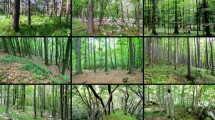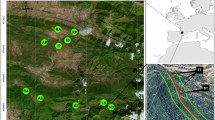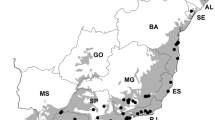Abstract
We investigated how environmental variables explain patterns of tree regeneration in high altitude sub-tropical Quercus-dominated forests by: (1) determining whether the seedling and sapling communities show non-random spatial patterns of floristic composition; (2) identifying which environmental variables explain the observed patterns of floristic composition; (3) examining if similarity in floristic composition is related to similarity in environmental variables. We used data gathered in permanent plots established across 10 km in high altitude sub-tropical Quercus-dominated forests. Our analyses consisted of unconstrained ordination analyses (Non-metric Multidimensional Scaling) to characterize the spatial patterns of floristic composition; constrained ordination analyses (Canonical correspondence analysis) to assess the contribution of environmental variables in explaining patterns of floristic composition and, the simple and partial Mantel test to correlate the floristic composition similarity to environmental similarity. Our results provided evidence of non-random spatial patterns of floristic distribution due to structured environmental filters such as canopy-related variables, litter, grazing and aspect. Floristic compositional similarity did not depend on geographical distance between sites or on differences in their environment; therefore a number of plots were similar in floristic composition, in both seedlings and saplings, but have no environmental similarity.






Similar content being viewed by others
References
Baker PJ, Wilson JS (2003) Coexistence of tropical tree species. Nature 422:581–582
Baldeck CA, Harms KE, Yavitt JB, John R, Turner BL, Valencia R, Navarrete H, Bunyavejchewin S, Kiratiprayoon S, Yaacob A, Supardi MNN, Davies SJ, Davies SJ, Hubbell SP, Chuyong GB, Kenfack D, Thomas DW, Dalling JW (2013) Habitat filtering across tree life stages in tropical forest communities. Proc R Soc 280:20130548. doi:10.1098/rspb.2013.0548
Barot S (2004) Mechanisms promoting plant coexistence: can all the proposed processes be reconciled? Oikos 106(1):185–192
Beckage B, Clark JS (2003) Seedling survival and growth of three forest tree species: the role of spatial heterogeneity. Ecology 84:1849–1861
Beers TW (1969) Slope correction in horizontal point sampling. J For 67:188–192
Bonnet E, Van der Peer Y (2002) zt: a software tool for simple and partial Mantel tests. J Stat Softw 7(10):10–17
Boulant N, Kunstler G, Rambal S, Lepart J (2008) Seed supply, drought, and grazing determine spatio-temporal patterns of recruitment for native and introduced invasive pines in grasslands. Divers Distrib 14:862–874
Bowman DMJS, Minchin PR (1987) Environmental relationships of woody vegetation patterns in the Australian Monsoon Tropics. Aust J Bot 35:151–169
Brokaw NVL, Busing R (2000) Niche versus chance and tree diversity in forests gaps. Trends Ecol Evol 15(5):183–188
Burslem DFRP, Whitmore TC, Brown GC (2000) Short-term effects of cyclone impact and long-term recovery of tropical rain forest on Kolombangara, Solomon Islands. J Ecol 88:1063–1078
Burton JI, Mladenoff DJ, Clayton MK, Forrester JA (2011) The roles of environmental filtering and colonization in the fine-scale spatial patterning of ground-layer plant communities in north temperate deciduous forests. J Ecol 99:764–776
Callaway RM (1992) Effect of shrubs on recruitment of Quercus douglassii and Quercus lobata in California. Ecology 73(6):2118–2128
Caspersen JP, Saprunoff M (2005) Seedling recruitment in a northern temperate forest: the relative importance of supply and establishment limitation. Can J For Res 35:978–989
Colwell RK (2009) EstimateS: statistical estimation of species richness and shared species from samples. Version 8.2 edn. http://purl.oclc.org/estimates
Condit R, Pitman N, Leigh EGJ, Chave J, Terborgh J, Foster RB, Núñez PV, Aguilar S, Valencia R, Villa G, Muller-Landau HC, Losos E, Hubbell SP (2002) Beta-diversity in tropical forest trees. Science 295(5555):666–669
Cuevas JG (2002) Episodic regeneration at the Nothofagus pumilio alpine timberline in Tierra del Fuego, Chile. J Ecol 90:60–62
de Mazancourt C (2001) Consequences of community drift. Science 293(5536):1772
De’ Ath G (1999) Extended dissimilarity: a method of robust estimation of ecological distances from high beta diversity data. Plant Ecol 144:191–199
Farris-Lopez K, Denslow JS, Moser B, Passmore H (2004) Influence of a common palm, Oenocarpus mapora, on seedling establishment in a tropical moist forest in Panama. J Trop Ecol 20:429–438
Fortin M-J, Gurevitch J (2001) Mantel tests. In: Scheiner SM, Gurevitch J (eds) Design and analysis of ecological experiments, 2nd edn. Oxford University Press, Oxford, pp 308–326
Foster P (2001) The potential negative impacts of global climate change on tropical montane cloud forests. Earth Sci Rev 55:73–106
Frontier S (1976) Étude de la decroissance des valeurs propers dans une analyze en composantes principales: comparison avec le modéle de baton brisé. J Exp Mar Biol Ecol 25:67–75
García D, Houle G (2005) Fine-scale spatial patterns of recruitment in red oaks (Quercus rubra): what matters most, abiotic or biotic factors? Ecoscience 12(2):223–235
Gómez-Aparicio L (2008) Spatial patterns of recruitment in Mediterranean plant species: linking the fate of seeds, seedlings and saplings in heterogeneous landscapes at different scales. J Ecol 96:1128–1140
Gómez-Aparicio L, Pérez-Ramos IM, Mendoza I, Matías L, Quero JL, Castro J, Zamora R, Marañón T (2008) Oak seedling survival and growth along resource gradients in Mediterranean forests: implications for regeneration in current and future environmental scenarios. Oikos 117(11):1683–1699
Gonzalez-Espinosa M, Meave JA, Ramírez-Marcial N, Toledo-Aceves T, Lorea-Hernández FG, Ibarra-Manríquez G (2012) Los bosques de niebla de México: conservación y restauración de su componente arbóreo. Ecosistemas 21(1–2):36–52
Gotelli NJ, Colwell RK (2001) Quantifying biodiversity: procedures and pitfalls in the measurement and comparison of species richness. Ecol Lett 4:379–391
Harcombe PA, Bill CJ, Fulton M, Glitzenstein JS, Marks PL, Elsik IS (2002) Stand dynamics over 18 years in a southern mixed hardwood forest, Texas, USA. J Ecol 90:947–957
Hernández-Vargas G, Sánchez-Velásquez LR, Carmona Valdovinos TF, Pineda-López MdR, Cuevas-Guzmán R (2000) Efecto de la ganadería extensiva sobre la regeneración arbórea de los bosques de la Sierra de Manantlán. Madera y Bosques 6(2):13–28
Hirayama K, Sakimoto M (2003) Spatial distribution of canopy and subcanopy species along a sloping topography in a cool-temperate conifer-hardwood forest in the snowy region of Japan. Ecol Res 18:443–454
Houle G (1992) Spatial relationship between seed and seeling abundance and mortality in a deciduous forest of north-eastern North America. J Ecol 80(1):99–108
Hubbell SP (2001) The unified neutral theory of biodiversity and biogeography. Monographs in population biology 32, 1st edn. Princeton University Press, Princeton, New Jersey
Hubbell SP, Foster RB, O’Brien ST, Harms KE, Condit R, Wechsler B, Wright SJ, de Loo Lao S (1999) Light-gap disturbances, recruitment limitation, and tree diversity in a neotropical forest. Science 283:554–557
Jabot F, Etienne RS, Chave J (2008) Reconciling neutral community models and environmental filtering: theory and an empirical test. Oikos 117:1308–1320
Jackson D (1993) Stopping rules in principal components analysis: a comparison of heuristical and statistical approaches. Ecology 74(8):2204–2214
Jolliffe IT (1973) Discarding variables in a principal component analysis. II: real data. J R Stat Soc Ser C (Appl Stat) 22:21–31
Kenkel NC, Orlóci L (1986) Applying metric and nonmetric multidimensional scaling to ecological studies: some new results. Ecology 67(4):919–928
King J, Jackson D (1999) Variable selection in large environmental data sets using principal components analysis. Environmetrics 10:67–77
Kobe RK, Vriesendorp CF (2009) Size of sampling unit strongly influences detection of seedling limitation in a wet tropical forest. Ecol Lett 12:220–228
Kruskal JB (1964) Nonmetric multidimensional scaling: a numerical method. Psychometrika 29(2):115–129
Liu Y, Tang Z, Fang J (2014) Contribution of environmental filtering and dispersal limitation to species turnover of temperate deciduous broad-leaved forest in China. Appl Veg Sci. doi:10.1111/avsc.12101
McCune B, Mefford MJ (1999) PC-ORD. Multivariate analysis of ecological data, version 4, 4th edn. MjM Software Design, Gleneden Beach
McCune B, Dey J, Peck J, Heiman K, Will-Wolf S (1997) Regional gradients in lichen communities of the southeast United States. Bryol 100(2):145–158
Mitchell PL, Whitmore TC (1993) Use of hemispherical photographs in forest ecology: calculation of absolute amount of radiation beneath the canopy. Occasional Papers No. 44. Oxford Forestry Institute. Department of Plant Sciences, University of Oxford, Oxford, UK
Nebel G, Dragsted J, Vanclay JK (2001) Structure and floristic composition of flood plain forest in the Peruvian Amazon. II The understorey of restinga forest. For Ecol Manage 150:59–77
Olvera-Vargas M, Figueroa-Rangel BL (2012) Caracterización estructural de bosques montanos dominados por encino en el centro-occidente de México. Ecosistemas 21(1–2):74–84
Olvera-Vargas M, Moreno Gómez S, Figueroa-Rangel BL (1996) Sitios permanentes de investigación Silvícola: Manual para su establecimiento. Libros Técnicos del Instituto Manantlán, Primera edn. Universidad de Guadalajara, Guadalajara, Jalisco, México
Olvera-Vargas M, Figueroa-Rangel BL, Vázquez-López JM (2010) Is there environmental differentiation in the Quercus-dominated forests of west-central Mexico? Plant Ecol 211(2):321–335
Tropicos.org Missouri Botanical Garden (2013). <http://www.tropicos.org>. Accessed 17 Jul 2013
Ramirez-Marcial N, Gonzalez-Espinosa M, Williams-Linera G (2001) Anthropogenic disturbance and tree diversity in Montane rain forests in Chiapas, Mexico. For Ecol Manage 154:311–326
Rees M, Mangel M, Turnbull L, Sheppard A, Briese D (2000) The effect of heterogeneity on dispersal and colonization in plants. In: Hutchings MJ, John EA, Stewart AJA (eds) The ecological consequences of environmental heterogeneity, 1st edn. Blackwell Science Ltd, Oxford, pp 237–265
Seaby RMH, Henderson PA, Prendergast JR (2004) Community analysis package V. 301, 3.01 edn. PISCES, Conservation. Ltd., Lymington, Hampshire, UK
Sternberg M, Shoshany M (2001) Influence of slope aspect on Mediterranean woody formations: comparison of a semiarid and an arid site in Israel. Ecol Res 16:335–345
Svenning J-C (2001) On the role of microenvironmental heterogeneity in the ecology and diversification of neotropical rain-forest palms (Arecaceae). Bot Rev 67(1):1–53
Svenning JC, Kinner DA, Stallard RF, Engelbrecht BMJ, Wright SJ (2004) Ecological determinism in plant community structure across a tropical forest landscape. Ecology 85(9):2526–2538
ter Braak CJF (1986) Canonical correspondence analysis: a new eigenvector technique for multivariate direct gradient analysis. Ecology 67(5):1167–1179
ter Braak CJF, Smilauer P (1998) CANOCO reference manual and user’s guide to Canoco for windows: software for canonical community ordination (version 4), version 4 edn. Centre for Biometry Wageningen, CPRO-DLO, Wageningen, The Netherlands
Terborgh J, Nuñez-Iturri G, Pitman N, Cornejo Valverde F, Alvarez P, Swamy V, Pringle EG, Timothy Paine CE (2008) Tree recruitment in an empty forest. Ecology 89(6):1757–1768
Tuomisto H, Ruokolainen K (2006) Analyzing or explaining beta diversity? Understanding the targets of different methods of analysis. Ecology 87:2697–2708
Tuomisto H, Ruokolainen K, Yli-Halla M (2003) Dispersal, environment, and floristic variation of western Amazonian forests. Science 299(5604):241–244
Vázquez-García JA, Cuevas-Guzmán R, Cochrane TS, Iltis HH, Santana-Michel FJ, Guzmán-Hernández L (1995) Flora de Manantlán, vol 13, 1st edn. Botanical Research Institute of Texas, Inc, Texas
Wang G, Zhou G, Yang L, Li Z (2002) Distribution, species diversity and life-form spectra of plant communities along an altitudinal gradient in the northern slopes of Qilianshan, Mountains, Gansu, China. Plant Ecol 165(2):169–181
Acknowledgments
We are greatly indebted to J. Martín Vázquez-López, Oscar Sánchez Jiménez and Abel Ceja Gutiérrez for his valuable assistance during the fieldwork. Two anonymous reviewers improved substantially this paper with their comments. Universidad de Guadalajara provided funds for the fieldwork.
Author information
Authors and Affiliations
Corresponding author
Electronic supplementary material
Below is the link to the electronic supplementary material.
About this article
Cite this article
Olvera-Vargas, M., Figueroa-Rangel, B.L. & Guzmán, R.C. Environmental filters and patterns of tree regeneration in high altitude sub-tropical Quercus-dominated forests. Ecol Res 29, 711–721 (2014). https://doi.org/10.1007/s11284-014-1163-0
Received:
Accepted:
Published:
Issue Date:
DOI: https://doi.org/10.1007/s11284-014-1163-0




